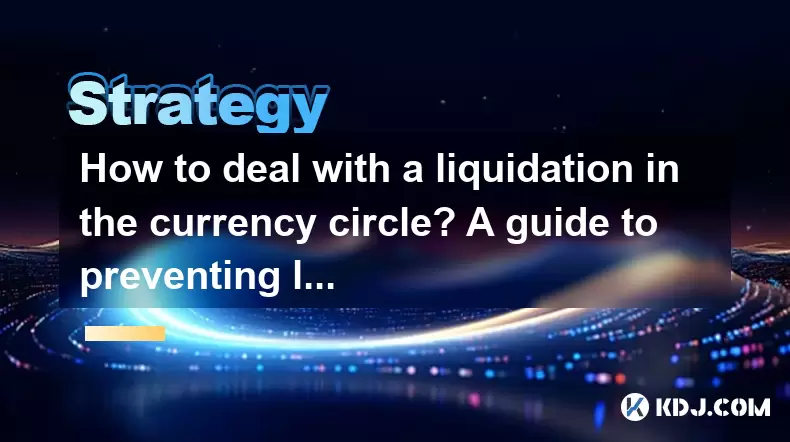-
 bitcoin
bitcoin $123963.239194 USD
1.37% -
 ethereum
ethereum $4529.082464 USD
1.07% -
 xrp
xrp $2.983640 USD
0.71% -
 tether
tether $1.000287 USD
0.02% -
 bnb
bnb $1179.874393 USD
2.99% -
 solana
solana $230.633678 USD
1.55% -
 usd-coin
usd-coin $0.999835 USD
0.03% -
 dogecoin
dogecoin $0.254240 USD
1.34% -
 tron
tron $0.341176 USD
0.15% -
 cardano
cardano $0.842285 USD
0.52% -
 hyperliquid
hyperliquid $48.537896 USD
-0.86% -
 chainlink
chainlink $21.863092 USD
-0.84% -
 ethena-usde
ethena-usde $0.999743 USD
-0.07% -
 sui
sui $3.579561 USD
-0.18% -
 stellar
stellar $0.403418 USD
2.67%
How to deal with a liquidation in the currency circle? A guide to preventing liquidation risks
Liquidation in crypto happens when market moves against a trader's position, causing losses that exceed available margin; using stop-loss orders and maintaining adequate margin can help prevent it.
May 28, 2025 at 04:50 pm

Dealing with liquidation in the cryptocurrency circle can be a stressful experience, but with the right knowledge and strategies, you can minimize the risks and potentially prevent it from happening. Understanding what liquidation is and how it occurs is the first step in effectively managing your crypto investments. In this guide, we'll delve into the specifics of liquidation, explore the reasons behind it, and provide actionable steps to help you prevent liquidation risks.
What is Liquidation in the Cryptocurrency Market?
Liquidation in the cryptocurrency market occurs when a trader's position is forcibly closed by the exchange due to insufficient funds to meet margin requirements. This typically happens when the market moves against the trader's position, and the losses exceed the available margin. Liquidation is more common in leveraged trading, where traders borrow funds to amplify their positions. When the market price hits a certain threshold, known as the liquidation price, the exchange will automatically close the position to prevent further losses.
Why Does Liquidation Happen?
Liquidation can occur for several reasons, but the most common ones are related to market volatility and inadequate risk management. When the market experiences sudden and significant price movements, it can quickly push a trader's position into a loss. If the trader does not have enough margin to cover the loss, the exchange will liquidate the position. Additionally, using high leverage increases the risk of liquidation, as even small price movements can lead to significant losses.
How to Identify the Risk of Liquidation
To prevent liquidation, it's crucial to identify the risk early. Monitoring your position's liquidation price and maintaining adequate margin are key steps in managing this risk. Most trading platforms provide tools to help you track your liquidation price, which is the price at which your position will be forcibly closed. By keeping an eye on this price and ensuring your margin is sufficient, you can take proactive steps to avoid liquidation.
Strategies to Prevent Liquidation
There are several strategies you can employ to minimize the risk of liquidation:
Use Stop-Loss Orders: A stop-loss order automatically closes your position when the market reaches a certain price, helping to limit your losses. By setting a stop-loss order at a level that is above your liquidation price, you can prevent your position from being liquidated.
Adjust Your Leverage: Using lower leverage reduces the risk of liquidation. While higher leverage can amplify your gains, it also increases the potential for significant losses. Consider using less leverage, especially in volatile markets, to give yourself more room to maneuver.
Regularly Monitor Your Positions: Keeping a close eye on your open positions allows you to respond quickly to market changes. Regular monitoring can help you identify when a position is at risk of liquidation, giving you time to take action.
Maintain Adequate Margin: Ensuring you have enough margin in your account is essential for preventing liquidation. If your position starts to move against you, having additional margin can help you weather the storm without being liquidated.
Diversify Your Portfolio: Spreading your investments across different assets can help mitigate the risk of liquidation. If one position is performing poorly, gains from other positions can help offset the losses and prevent liquidation.
What to Do If You Face Liquidation
If you find yourself facing liquidation, there are steps you can take to mitigate the damage:
Close Positions Manually: If you notice your position is approaching the liquidation price, you can manually close it to avoid being liquidated. This allows you to control the timing and potentially minimize your losses.
Add More Margin: If you have additional funds, you can deposit more margin into your account to increase your position's safety buffer. This can help prevent liquidation if the market continues to move against you.
Reduce Position Size: If you cannot add more margin, consider reducing the size of your position. By closing part of your position, you can decrease the amount of margin required and lower the risk of liquidation.
Stay Calm and Assess: Panic can lead to poor decision-making. Take a moment to assess the situation and consider your options carefully. Sometimes, the best course of action may be to accept the loss and move on.
Tools and Resources to Help Prevent Liquidation
Several tools and resources are available to help you manage and prevent liquidation:
Trading Platforms: Many trading platforms offer features like real-time margin monitoring, liquidation price calculators, and risk management tools. Familiarize yourself with these features to better manage your positions.
Risk Management Calculators: Online risk management calculators can help you determine the appropriate leverage and position size based on your risk tolerance and account balance.
Educational Resources: Numerous educational resources, such as articles, videos, and webinars, are available to help you learn about risk management and trading strategies. Investing time in learning can significantly improve your ability to prevent liquidation.
Community and Forums: Engaging with the crypto community and participating in forums can provide valuable insights and tips from experienced traders. Learning from others' experiences can help you avoid common pitfalls that lead to liquidation.
Frequently Asked Questions
Q: Can I recover funds after a liquidation?A: Once a position is liquidated, the funds used as margin are typically used to cover the losses. However, some exchanges may offer a partial refund if the liquidation results in a surplus. It's important to review the specific policies of your trading platform.
Q: How does the choice of exchange affect the risk of liquidation?A: Different exchanges have varying policies and mechanisms for handling liquidations. Some may offer more favorable conditions, such as lower fees or more lenient margin requirements. Researching and choosing a reputable exchange with transparent liquidation policies can help mitigate the risk.
Q: Is it possible to avoid liquidation entirely?A: While it's challenging to avoid liquidation entirely, especially in highly volatile markets, implementing robust risk management strategies can significantly reduce the likelihood. Using lower leverage, setting stop-loss orders, and maintaining adequate margin are key practices to minimize the risk.
Q: How does market volatility impact the risk of liquidation?A: Market volatility increases the risk of liquidation by causing rapid and significant price movements. In volatile markets, positions can quickly move into loss territory, increasing the chances of hitting the liquidation price. Traders should be particularly cautious and adjust their strategies accordingly during periods of high volatility.
Disclaimer:info@kdj.com
The information provided is not trading advice. kdj.com does not assume any responsibility for any investments made based on the information provided in this article. Cryptocurrencies are highly volatile and it is highly recommended that you invest with caution after thorough research!
If you believe that the content used on this website infringes your copyright, please contact us immediately (info@kdj.com) and we will delete it promptly.
- BlockDAG, DOGE, HYPE Sponsorship: Crypto Trends Shaping 2025
- 2025-10-01 00:25:13
- Deutsche Börse and Circle: A StableCoin Adoption Powerhouse in Europe
- 2025-10-01 00:25:13
- BlockDAG's Presale Buzz: Is It the Crypto to Watch in October 2025?
- 2025-10-01 00:30:13
- Bitcoin, Crypto, and IQ: When Genius Meets Digital Gold?
- 2025-10-01 00:30:13
- Stablecoins, American Innovation, and Wallet Tokens: The Next Frontier
- 2025-10-01 00:35:12
- NBU, Coins, and Crypto in Ukraine: A New Yorker's Take
- 2025-10-01 00:45:14
Related knowledge

Practical parameter settings for a Bitcoin multi-timeframe moving average system
Sep 18,2025 at 10:54pm
Optimizing Timeframe Combinations for Bitcoin Trading1. Selecting appropriate timeframes is crucial when building a multi-timeframe moving average sys...

How can I filter out false breakouts in Dogecoin high-frequency trading?
Sep 22,2025 at 01:00am
Understanding False Breakouts in Dogecoin Trading1. A false breakout occurs when Dogecoin's price appears to move beyond a defined support or resistan...

Techniques for identifying tops and bottoms in the Bitcoin on-chain NVT model
Sep 20,2025 at 07:54pm
Understanding the NVT Model in Bitcoin Analysis1. The Network Value to Transactions (NVT) ratio is often described as the 'P/E ratio' of the cryptocur...

What does the surge in open interest in Bitcoincoin futures mean?
Sep 20,2025 at 11:18pm
Understanding the Surge in Dogecoin Futures Open Interest1. A surge in open interest within Dogecoin futures indicates a growing number of active cont...

How can I use the Ethereum USDT premium to gauge market sentiment?
Sep 18,2025 at 11:55pm
Understanding the Ethereum USDT Premium1. The Ethereum USDT premium refers to the price difference between USDT (Tether) traded on Ethereum-based plat...

What should I do if Ethereum staking yields decline?
Sep 20,2025 at 06:18am
Understanding the Causes Behind Declining Ethereum Staking Yields1. The Ethereum network transitioned to a proof-of-stake consensus mechanism with the...

Practical parameter settings for a Bitcoin multi-timeframe moving average system
Sep 18,2025 at 10:54pm
Optimizing Timeframe Combinations for Bitcoin Trading1. Selecting appropriate timeframes is crucial when building a multi-timeframe moving average sys...

How can I filter out false breakouts in Dogecoin high-frequency trading?
Sep 22,2025 at 01:00am
Understanding False Breakouts in Dogecoin Trading1. A false breakout occurs when Dogecoin's price appears to move beyond a defined support or resistan...

Techniques for identifying tops and bottoms in the Bitcoin on-chain NVT model
Sep 20,2025 at 07:54pm
Understanding the NVT Model in Bitcoin Analysis1. The Network Value to Transactions (NVT) ratio is often described as the 'P/E ratio' of the cryptocur...

What does the surge in open interest in Bitcoincoin futures mean?
Sep 20,2025 at 11:18pm
Understanding the Surge in Dogecoin Futures Open Interest1. A surge in open interest within Dogecoin futures indicates a growing number of active cont...

How can I use the Ethereum USDT premium to gauge market sentiment?
Sep 18,2025 at 11:55pm
Understanding the Ethereum USDT Premium1. The Ethereum USDT premium refers to the price difference between USDT (Tether) traded on Ethereum-based plat...

What should I do if Ethereum staking yields decline?
Sep 20,2025 at 06:18am
Understanding the Causes Behind Declining Ethereum Staking Yields1. The Ethereum network transitioned to a proof-of-stake consensus mechanism with the...
See all articles










































































